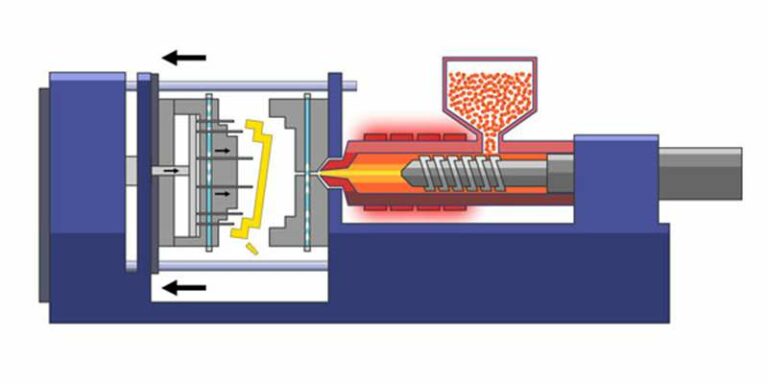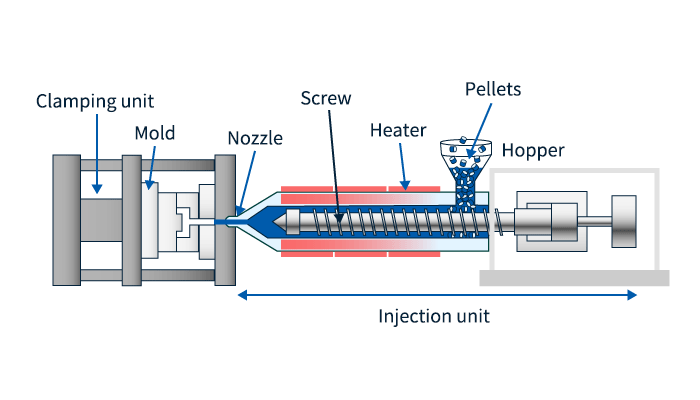The Function of Plastic Injection Molding in Creating Cost-efficient Industrial Parts
The Function of Plastic Injection Molding in Creating Cost-efficient Industrial Parts
Blog Article
Comprehending the Basics of Plastic Shot Molding Processes
Plastic shot molding offers as a foundation of modern production, giving a systematic strategy to creating complicated parts with accuracy. Discovering these crucial components can expose exactly how even minor changes can lead to substantial enhancements in production end results, elevating concerns about the potential for technology in this well-known process.
What Is Plastic Injection Molding?
Plastic shot molding is a widely made use of manufacturing procedure that transforms thermosetting and thermoplastic materials right into accurate and intricate shapes. This strategy is favored for its capability to generate high volumes of the same components with outstanding accuracy, making it a crucial method in numerous industries, including vehicle, consumer products, and clinical gadgets.
The process entails thawing the picked plastic material and injecting it into a mold under high pressure. The mold and mildew, developed to the requirements of the desired part, enables the liquified plastic to take shape as it strengthens and cools down. As soon as the material has solidified, the mold and mildew is opened up, and the ended up element is expelled.
Plastic shot molding offers a number of advantages, consisting of lowered waste, consistency in production, and the capability to integrate complex layouts that might be testing with various other manufacturing methods. Additionally, it supports a broad variety of materials, each offering special homes that can be customized for certain applications. As sectors remain to introduce, plastic shot molding stays at the leading edge, allowing the advancement of sophisticated products that meet developing consumer needs.
The Injection Molding Refine
The shot molding process is a sophisticated technique that entails a number of essential stages to produce top quality plastic elements. Initially, plastic pellets are fed into a warmed barrel where they are merged a viscous liquid. This molten plastic is then injected under high stress right into a precision-engineered mold, which shapes the product right into the preferred form.
As soon as the mold and mildew is filled up, the plastic is allowed to cool and strengthen, taking the form of the mold cavity. Air conditioning time is vital, as it impacts the cycle time and the final buildings of the shaped part. After enough cooling, the mold opens up, and the finished part is ejected using ejector pins.

Products Made Use Of in Shot Molding
Different products can be used in the injection molding process, each offering distinct residential properties that accommodate certain applications. One of the most frequently utilized materials include thermoplastics, thermosetting plastics, and elastomers.

Thermosetting plastics, like epoxy and phenolic resins, go through a chemical change during the healing procedure, leading to an inflexible, stringent structure. These materials are excellent for applications needing high warmth resistance and architectural integrity, commonly used in electrical insulators and vehicle components.
Elastomers, consisting of silicone and rubber-based products, provide flexibility and durability. Their special residential or commercial properties make them appropriate for applications that require flexibility, such as gaskets and seals.
Additionally, specialty materials like bio-based plastics and compounds are obtaining traction for their environmental benefits and enhanced performance qualities, expanding the extent of shot molding applications in numerous sectors. Understanding the residential or commercial properties of these materials is vital for picking the ideal kind for details tasks.
Benefits of Shot Molding
Shot molding sticks out as an extremely effective manufacturing procedure that offers many benefits for creating complicated parts with precision. Among the most considerable benefits is the ability to create intricate layouts that would certainly be tough or impossible to accomplish with other methods (Plastic Injection Molding). The procedure enables for tight tolerances and detailed attributes, guaranteeing premium components
Additionally, shot molding is understood for its rapid manufacturing abilities, making it an optimal choice for high-volume production. When the mold and mildew is produced, parts can be generated rapidly, reducing preparations and increasing total efficiency. This efficiency not just lowers manufacturing costs yet also gives a competitive side on the market.
The versatility of products made use of in injection molding additionally enhances its charm. A wide variety of thermoplastics and thermosetting polymers can be employed, enabling manufacturers to pick products that best satisfy their particular needs, consisting of stamina, adaptability, and warm resistance.
Furthermore, the procedure decreases waste, as excess material can typically be reused and recycled. This sustainability facet contributes to a decreased ecological influence, making shot molding a responsible production choice. Generally, the benefits of shot molding make it a recommended method for numerous markets.
Aspects Influencing Item Quality
While numerous elements can influence product high quality in injection molding, comprehending these aspects is vital for attaining optimum outcomes. Trick facets link consist of product option, refining criteria, and mold and mildew layout.
Product option plays a crucial duty, as different polymers display special properties that impact flowability, strength, and thermal stability. Inadequate material option can cause defects such as warping or incomplete dental filling.
Handling specifications, including temperature level, cycle, and pressure time, must be diligently regulated. Variations in these settings can cause variances in part dimensions and surface area finish. For instance, exceedingly high temperatures might create deterioration of the polymer, while inadequate stress can lead to brief shots.
Mold layout is similarly important, as it figures out the flow of the molten plastic and the cooling procedure. Improperly designed mold and mildews may bring about uneven air conditioning rates, causing residual stress and anxieties and dimensional errors.

Final Thought
To conclude, plastic injection molding serves as a crucial manufacturing process that enables the efficient manufacturing of high-quality parts. Proficiency of the shot molding process, including the understanding of materials and the impact of numerous aspects on product quality, is important for achieving optimal outcomes. The advantages of this method, such as cost-effectiveness and design adaptability, more highlight its importance across numerous markets, solidifying its status as a recommended option for high-volume production.
Plastic shot molding serves as a cornerstone of modern-day production, providing a systematic approach to producing complex elements with precision.Plastic injection molding uses numerous advantages, including lowered waste, consistency in manufacturing, and the ability to incorporate detailed styles that may be testing with other making methods (Plastic Injection this website Molding). As sectors continue to introduce, plastic injection molding continues to be at the forefront, making it possible for the development of innovative products that satisfy developing customer demands
The shot molding procedure is an advanced strategy that involves a number of key phases to generate premium plastic components.In final thought, plastic shot molding serves as an important production process that allows the reliable production of top notch components.
Report this page